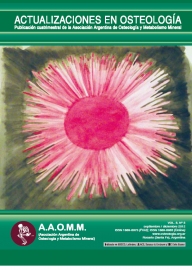Hipofosfatasia: fsiopatología y tratamiento
Autores: José Luis Millán, Horacio Plotkin
Resumen
Hypophosphatasia (HPP) is the inborn-error-of-metabolism caused by loss-of-function mutation(s) in the gene that encodes the tissue-nonspecific isozyme of alkaline phosphatase (TNAP). The disease can be classified according to patient age when the first signs and symptoms manifest; i.e., perinatal, infantile, childhood, adult HPP and even odonto HPP. Babies with the perinatal/infantile forms of HPP often die with severe rickets and sometimes hypercalcemia and vitamin B6-dependent seizures. The primary biochemical defect in HPP is a deficiency of TNAP catalytic activity that leads to elevated circulating levels of inorganic pyrophosphate (PPi), a potent calcification inhibitor. To-date, the management of HPP has been essentially symptomatic or orthopedic. However, enzyme replacement therapy with mineral targeting TNAP (sALP-FcD10, a.k.a. ENB-0040 or asfotase alfa) has shown remarkably successful results in a mouse model of HPP (Alpl-/- mice). Administration of mineral-targeting TNAP from birth increased survival and prevented the seizures, rickets, as well as all the tooth abnormalities, including dentin, acelular cementum, and enamel defects, in this model of severe HPP. Clinical trials using mineral-targeted TNAP in children 3 years of age or younger with life-threatening HPP was associated with healing of the skeletal manifestations of HPP as well as improved respiratory and motor function. Improvement is still being observed in the patients receiving continued asfotase alfa therapy, with more than 3 years of treatment in some children. Asfotase alfa appears to be a potential enzyme replacement therapy in patients with life-threatening HPP. Keywords: Hypophosphatasia, alkaline phosphatase, asfotase alfa.






